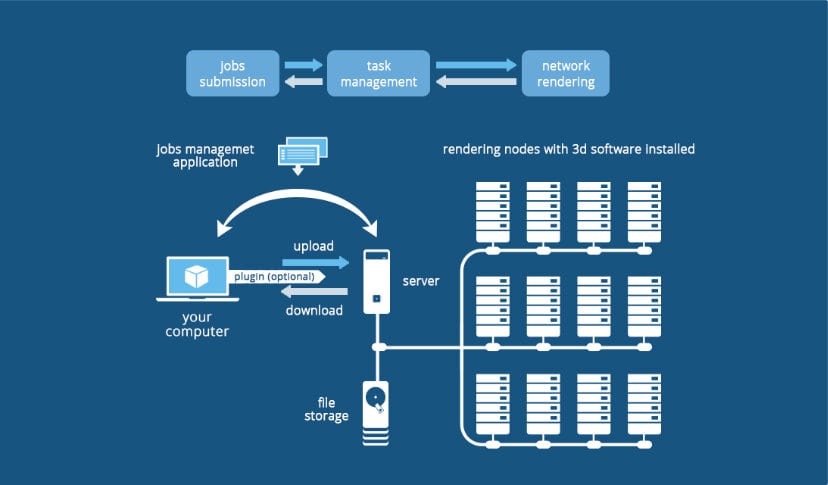Creating a detailed 3D model requires enormous processing power. Rendering a 3D model typically takes a few days. To avoid waiting for your local computer to complete the CAD rendering process, you can use cloud resources. With cloud rendering, you can create complex 3D models much faster and without having to invest in expensive on-site IT infrastructure.
Cloud computing draws resources from powerful computers in different locations known as render farms. Remote servers, rather than a single local computer, can quickly perform the resource-intensive processing tasks required for photorealistic 3D rendering.
Cloud rendering is a relatively new concept in the world of computer graphics. It refers to the process of using cloud computing resources to render 3D images and animations. Rendering in the cloud has become increasingly popular in recent years, as it offers a number of advantages over traditional rendering methods. However, it also presents some unique challenges that must be addressed in order to fully realize its potential.
What is Cloud Rendering?
At its core, cloud rendering involves using remote servers to perform the complex calculations required to render high-quality images and animations. This is done by uploading the necessary files and data to the cloud, where they are processed by powerful server hardware. The resulting images are then downloaded back to the user's device.
How Rendering Works?

Online rendering requires a render farm – a group of computers designed for rendering computations, assembled into a single network. Depending on the system's capacity, it can have several thousand individual nodes.
Since the rendering process is performed by different algorithms render farms are divided into 2 categories:
-
CPU rendering – CPU performance is used for computation.
-
GPU-rendering – calculations are performed by the graphics processor.
Your task can be done on several dozen nodes at once, which saves a lot of time. Therefore, for a small fee, the user gets access to powerful facilities for a while. You can choose to pay on a subscription basis if you need the services regularly, or use the computing power of the cloud farms on a one-off basis.
Advantages of Using Cloud Rendering
One of the biggest advantages of cloud rendering is high speed. Servers in the cloud are more powerful than individual computers and can process large amounts of data much more quickly. This means that complex 3D scenes that might take hours or even days to render on a desktop computer can be completed in a matter of minutes or hours. This is a huge time saver for artists and designers who need to produce high quality work to tight deadlines.
Another benefit of cloud rendering is its scalability. With traditional rendering methods, the amount of computing power available is limited by the hardware available on the user's computer. So it can be slow to render complex scenes. With cloud rendering, however, users have access to unlimited computing resources, allowing them to render even the most complex scenes quickly and easily.
Cloud rendering also offers great flexibility. Because the rendering is done remotely, users access their files and work from anywhere with an internet connection. Artists and designers can work collaboratively on projects from different locations, without having to worry about transferring large files back and forth.
Challenges of Cloud Rendering
Despite these benefits, cloud rendering presents some unique challenges that need to be addressed in order to realize its full potential. One of the main challenges is security. Cloud rendering involves uploading sensitive files and data to remote servers, which means there is always a risk of data breaches or other security issues. To address this, cloud providers use advanced encryption and other security measures to protect customers' data.
Cloud rendering involves the use of remote servers. It can be difficult to ensure that all the necessary software and hardware is compatible with the user's PC. This leads to problems with file formats, software versions and other compatibility issues that can slow down the rendering process.
Finally, while cloud rendering is a cost-effective option for smaller projects, it can be expensive for larger projects or companies with multiple users. This is because providers charge based on the amount of computing resources used, which can add up quickly for large projects.
In conclusion, with careful planning and attention to security, cost, and compatibility issues, however, cloud rendering can be a powerful tool for artists and designers looking to create high-quality 3D images and animations.


